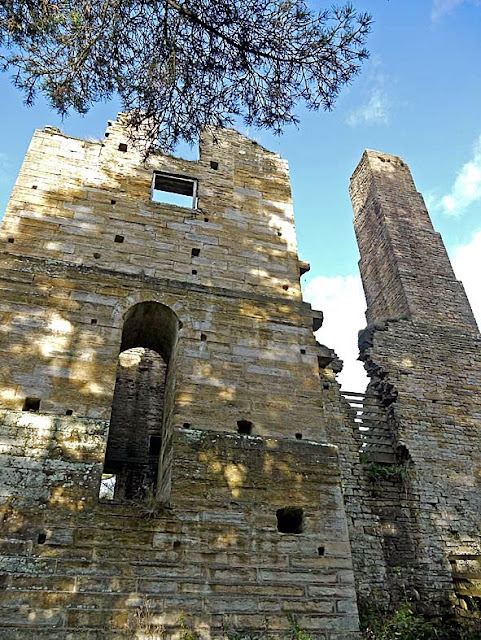This is the sight that greets you when you follow the track down from the delightfully-named Pennypie cottage towards Blanchland, at the mining hamlet of Shildon (not to be confused with the town of Shildon in County Durham) which is a mile north of Blanchland. All that's left of this community, that in its heyday numbered over 150 people, is a couple of cottages and this old engine house, together with some mine shafts in the hillside.

The engine house was built in 1806 by mine owner John Skottowe, to house a Boulton and Watt steam engine that was built to pump water from the underground lead mine shafts and tunnels. Waterwheel-driven pumps were no longer up to the job so he imported the latest technology from the tin mines of Cornwall. It's the only Cornish-style engine house in North East England. A contemporary account describes how 'a steam-engine of great power was erected, the cyclinedr being of 64 inches in diameter, and the main beam weighing upwards of nine tons'.
It should have solved Skottows' problems especially as he owned coal mines across the border in County Durham, but the steam engine turned out to be uneconomic and he reverted to waterwheel driven pumps, dismantling the steam engine and transporting it to Backworth colliery. There was no rail access to Blanchland when the mine engine was installed and even when a rail link did arrived (in 1834) the line ended at Parkhead, five miles away.
The likely reason why steam-driven pumping was abandoned is that this little valley is so remote. Even today, the roads quickly become treacherous after a snow fall and two centuries ago, when they were less well maintained and transport depended on horses and wagon wheels, they must often have been impassible in winter.
After the steam engine was removed the building was converted to miners' accommodation, with the addition of three floors inside, and it became known locally as 'Shildon Castle'. The mine went into decline, unable to compete with imported lead, and many of the miners emigrated - you can read fascinating accounts of some of them by clicking here
This is the slit in the wall where the beam of the steam engine would have rocked up and down. At the top of the slit you can see the fireplaces that were installed when the building was converted to workers' flats.
You can see more photographs of the site, before its recent restoration, by clicking here
There was a vigorous exchange of mine workers and mining technologies between Cornwall and Northumberland in the early 19th. century, which you can read about by clicking here
You can download a useful pdf guide to the geology and landscape around Blanchland by clicking here
You can download a detailed report on Blanchland and its surround area by clicking here
The engine house site has recently been cleared of the tangle of vegetation that threatened to engulf it and has been stabilised, so you can have a close look at the site. The disturbance has led to the germination of some interesting plants that would have been familiar to the people who once lived and worked here. There are some exceptionally fine specimens of common mullein or Aaron's rod, Verbascum thapsus, that often thrives in disturbed ground.
The plant produces a few new flowers each day along its tall flower spike, so blooming continues for several weeks in summer.....
.... and provides a constant supply of pollen for bumblebees over a prolonged period. It's easy to spot these visitors because their pollen baskets are always full of orange pollen.
Mullein is a biennial and produces a beautiful rosette of densely hairy leaves in the first year, that look particularly fine when they are covered with dew on sunny autumn mornings, then in the second year the flower spike elongates. The dense hairs were once shaved from the leaves, dried and used for making lamp wicks and tinder that ignited easily with the slightest spark. A mucilaginous extract of the leaves, boiled in milk, produced a medicine that that was used to treat coughs. It's tempting to think that the who worked in the constantly damp conditions underground here might well have used mullein plants for these purposes.
Mullein produces vast numbers of seeds but as Sir Edward Salisbury, former Director of Kew Gardens and author of the classic Weeds and Aliens discovered, most fall within about 12 feet of the plant and so it tends to occur in locally dense, self-seeded patches - as it has at this location.
According to C. Pierpoint Johnson in his treatise on The Useful Plants of Great Britain, published in 1863, the tiny seeds "are said to intoxicate fish when thrown into the water, and are used by the poachers for this purpose".
This musk mallow Malva moschata, growing in amongst the mulleins, is also a mucilaginous plant whose extracts were used as an emollient to treat pulmonary complaints.
It's tempting to speculate that this local concentration of plants with medicinal properties is not here by chance, but might have been used by the local miners when they were the amongst the few treatments for their ailments that were available to them. Maybe they are survivors from gardens of houses that have long since vanished .....




















































